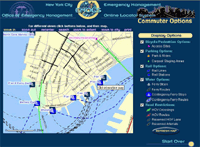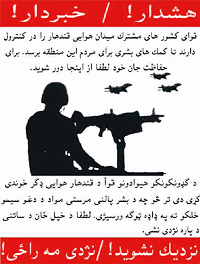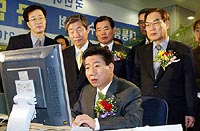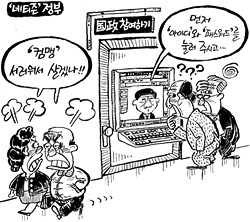gov
Together for the City We Love
![]() In February 1975, New York City reached the nadir of its financial crisis when underwriters withdrew from a $260 million bond issue, putting the the City on the verge of insolvency. To help generate income, the New York Commerce Commission hired ad agency Wells, Rich and Greene to develop a campaign that would promote New York City and state as a tourist destination. The slogan they came up with: I Love New York. The Commission hired designer Milton Glaser to develop a logo. When the ads came out in 1977, they featured New York celebrities including Frank Sinatra, Morgan Fairchild and Yul Brenner.
In February 1975, New York City reached the nadir of its financial crisis when underwriters withdrew from a $260 million bond issue, putting the the City on the verge of insolvency. To help generate income, the New York Commerce Commission hired ad agency Wells, Rich and Greene to develop a campaign that would promote New York City and state as a tourist destination. The slogan they came up with: I Love New York. The Commission hired designer Milton Glaser to develop a logo. When the ads came out in 1977, they featured New York celebrities including Frank Sinatra, Morgan Fairchild and Yul Brenner.
The campaign was an enormous success, running for 25 years, with no end in sight. (There’s certainly no shortage of fabulous I Love New York merchandise for sale around town.) The logo has become iconic and often imitated.
 In the aftermath of September 11, 2001, Glaser updated his design by adding a smudge to the lower corner of the heart and the words “More Than Ever.” The image must have struck a chord. It seemed to pop up in every shop window in town. Glaser, who’s taught design at the School of Visual Arts for 40 years, worked with the director of the school to print up posters. Students ran around handing out 5,000 posters, and New York’s papers reprinted the image for their readers to clip and post. Personally, I thought the image was corny, but a step up from all the flag waving. I did experience the incredible comradery of the people of New York City. Many, however, experienced incredible animosity and even violence.
In the aftermath of September 11, 2001, Glaser updated his design by adding a smudge to the lower corner of the heart and the words “More Than Ever.” The image must have struck a chord. It seemed to pop up in every shop window in town. Glaser, who’s taught design at the School of Visual Arts for 40 years, worked with the director of the school to print up posters. Students ran around handing out 5,000 posters, and New York’s papers reprinted the image for their readers to clip and post. Personally, I thought the image was corny, but a step up from all the flag waving. I did experience the incredible comradery of the people of New York City. Many, however, experienced incredible animosity and even violence.
At the bottom of the posters is text that specifically notes that the posters are not for sale. Glaser did make one exception, though, when he allowed WNYC, a public radio station, to sell posters to raise money to replace the broadcast tower and antenna that were destroyed when the towers collapsed. The gesture ultimately raised $190,000.
It’s a year and a half later and the city faces another financial crisis. Glaser has designed the third in a continuing series of messages: “Together for the City We Love.”
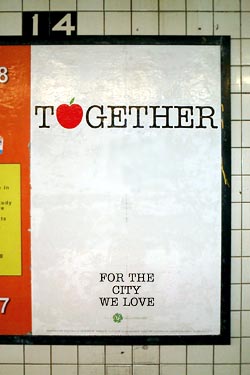 Glaser told the Daily News:
Glaser told the Daily News:
“His new phrase was inspired by the city’s fiscal crisis and the recent threat of a transit strike. Glaser sent City Hall several designs with the slogan, which he says could serve as a ‘rallying cry’ to help New Yorkers bond during tough times.”
When I first saw the new logo in the subway, I was skeptical. As a New Yorker, I will not be bullied into happiness or togetherness. Certainly, when the State sells unity, I wonder who stands to gain. “Community” is often used the gloss over difference and dissent. “You’re either with us, or against us.”
The design, however, is open to interpretation. One could just as easily use it at a block party or mass action. And I’m sure subway riders will note their own impressions on the ad’s generous white space.
As it turns out, the city chose not to use the design. Instead, Glaser and SVA will be publishing it on their own again — the public act of private individual, an educational institution, and its students. SVA also arranged ad space in the subways. The students will distribute the printed posters this weekend.
“The people of NYC seem to be losing that sense of cohesion we felt a year and a half ago,” says Glaser. He hopes the campaign will encourage people to be nicer to each other and may try to use it as a fundraiser for the City to help pay for some of the services being cut. “It’s a drop in the bucket, but it would have symbolic meaning.”
Meanwhile, the city government has plans of its own. Mayor Bloomberg has set up a permanent office and campaign to sell New York to big business and investors and to woo major events. The effort relies less on advertising and more on deals with the private sector and behind-the-scenes lobbying.
It has already brought back Grammy’s and next year’s WNBA All-Star game to New York, but also the Republican National Convention in 2004.
I for one will be out there protesting, together for the city we love.
Fresh Vegetables for Rotten Cops
Indonesian Police Urged to Grow Veggies
“Cash-strapped police shaking down citizens for some of the green stuff is part of daily life in Indonesia. To deter graft, a police chief wants his officers to develop green thumbs instead.
Bogor Police Col. Anton Bachrul Alam said Friday he was encouraging officers to grow tomatoes, lettuce and flowers at home to supplement their often meager income.
‘Their official wages are barely enough to live on. It’s better than extorting people or taking bribes,’ he said.
Alam said a hydrophonics expert would teach officers and their family to grow plants using nutrient solutions rather than soil, making them easier to harvest. A police cooperative will help them sell their crops, he said.
Bogor has about 3,000 policemen who earn on average one million rupiah ($111) per month.
Indonesia’s security forces are notorious for petty graft, running illegal enterprises and taking bribes from drug smugglers and gambling operators.”
Hard to say if this will cut down corruption — there are plenty of rich, well-fed people in the extortion racket. How about some transparency, accountability, or popular oversight to go with the tomatoes and cash?
Still, I love this idea. In addition to the extra income and food, urban gardens have all kinds of environmental and health benefits. And I love the image of hardened cops showing off a proud bouquet of home grown flowers, swapping gardening tips and recipes in the locker room, or picking on the new guy for his clearly inferior eggplants.
Whether
Why the urgent rush to war RIGHT NOW?
The longer the delay, the greater the risk of U.S. casualties.
From NBC 10:
“If Iraq is to be invaded, the greater the delay, the greater the potential problems. Temperatures that average 80 on April 1, rise to 110 in June, with some days as hot as 120.”
“A typical American soldier goes into combat with a heavy load, so if you send your troops into the Middle East during the warm part of the year, you are risking problems from heat stroke, sunstroke and all kinds of elements,” said Gregory Urwin of Temple University.
“The problem in fall is the combination of dry air and strong winds, which creates bad dust or sandstorms,” Schwartz said.
“It was a dust storm that brought down a helicopter that was part of the attempt to rescue the hostages in Iran.
“Weather and moon conditions are ideal right now. There is also something called moonrise and moonset. Even next week, there will be four to six hours of total darkness each night. The modern military may be less-dependant on moon phases than in the past, but if they wait too long, potential problems increase and ideal weather is unlikely until next winter.”
If the invasion is delayed just a few more weeks, perhaps it won’t actually happen...
Rating Congressional Web sites
The Congress Online Project today posted their report on second annual report on congressional Web sites. The report:
- Briefly describes the methodology and process we used to evaluate all 610 congressional Member office, standing committee, and leadership Web sites;
- Provides a detailed assessment of the overall performance of these sites;
- Identifies the 75 best Web sites on Capitol Hill — the Congress Online Gold, Silver, and Bronze Mouse Award winners — which can serve as models for offices wishing to improve their own sites;
- Identifies five fundamental building blocks for effective Web sites — and explains how offices can incorporate them into their own sites; and
- Describes the mistakes congressional offices are making with their online practices.
Lots of useful info here, though I wonder why the authors would talk to citizens to develop the methdology of the study, but not as part of the actual analysis itself.
Routing
“New York City averted a public transit strike recently, saving commuters and residents a metropolitan-size headache of getting around. But if it had come to that, the city was ready to help idle people find their way.
A week before the scheduled strike, the city’s Office of Emergency Management, the Department of Information Technology and Telecommunications, and Frankfort, Ky.-based PlanGraphics Inc. designed and developed an interactive online map that enabled users to view various alternative transportation options and vehicular restrictions.
The application, which took about a half-day to design and a week to develop, was activated from Friday evening, Dec. 13, to Monday noon, Dec. 16, the deadline for the strike, said Mike Wiley, a project manager for PlanGraphics in New York City. During that time, users viewed more than 70,000 custom maps with a peak of about 6,000 maps served up Sunday evening. Although the application was subsequently deactivated, it’s available should a similar situation occur in the future.
The system can highlight bicycle and pedestrian access sites, carpool staging areas, rail lines and stations, ferry stops and routes, including contingencies, as well as carpool-only routes and other road restrictions.
The application is based on the city’s Emergency Management Online Locator System, which allows New Yorkers to find hurricane evacuation routes or cooling centers during a heat wave.
PlanGraphics, which has a seven-year working relationship with the city, also helped develop an online map of the area around the World Trade Center shortly after the Sept. 11, 2001, terrorist attacks. Sometimes twice daily, the company or the city would update what areas were accessible by motor vehicles or pedestrians in the area and provide other information.
The company is also planning to update the city’s “My Neighborhood Statistics” application, which allows users to view 14 selected performance statistics about their community, such as air and noise complaints, structural fires, infant mortality, clean sidewalks, felonies and certified teachers. By the end of January, the system, which went live in September 2002, will show 80 different metrics.
The city also recently awarded PlanGraphics a three-year, $15.4 million contract to continue to develop and upgrade the city’s GIS data repository, and provide greater access as well as more customized applications for the public and city agencies.”
Other non-interactive maps were posted, but the site vanished from the Web as quickly as it was posted.
MapQuest has driving instructions, Staphangers .org used to have a working subway route finder, and the Department of Transportation has PDF of NYC bicycle routes, but I’ve not found anything that ties together NYC’s many transportation alternatives into one online application.
In a struggle that shook the City, the Transport Workers Union stood up to the Mayor’s intimidation and successfully fought cuts. They also pushed the City into developing the most comprehensive New York City route finder I’ve seen. The screen shots I found indicate that the target audience were those who work in lower Manhattan and Wall Street, but such a tool would be useful for everyone — and would indicate which neighborhoods are underserved. I hope they put it back online, with subway and bus info added.
Update, 9/12/2003: The lack of a integrated route finding system in NYC has prompted one New York City resident to build his own. It needs work, but integrates bus and subway connections quite nicely.
Night Letters
“The Partnership of Nations has secured the Qandahar Airport to ensure that Humanitarian Aid will reach the people of this area. For your own safety stay away.”
Leaflet War Rages in Afghan Countryside
“The war in Afghanistan is not just about bombing mountain hide-outs, it’s also about getting a message out. The result is a leaflet war that has littered the Afghan countryside with thousands of pieces of paper.
On one side are the United States and its allies, who use pamphlets with mugshots of fugitives and pictures of Taliban abuses to warn coalition enemies that there is no escape.
On the other side are the Taliban, al-Qaida and renegade rebel leader Gulbuddin Hekmatyar, whose much more prolific flyers warn foreign soldiers they are targets, or urge Islamic faithful to rise up against them in holy war.
The anti-American pamphlets are called ‘night letters,’ secretly circulated and strewn by the hundreds in towns, villages and countryside. Within the last few weeks, they turned up in the capital of Kabul for the first time.”
The AP story depicts much of the propaganda war centering on women’s bodies — U.S. forces shown searching a young girl vs. a member of the Taliban shown beating a woman.
However, of the U.S. flyers shown here, some are instructional — tune to this radio station, those yellow things are food packets — but most simply hawk moral platitudes and cash money rewards.
Under Orders
“Today, in Venezuela, the uniformed Armed Forces build housing and infrastructure. It’s interesting; one of the key demands of the ‘opposition’ is to prohibit the army from building houses! The poor cheer when the military enters their neighborhoods, because they’re usually coming to build some houses. Not, like before, when they came to round up the dissidents and repress the social movements.”
This interview on Indymedia prompted me to do a little googling.
President Chavez’s Plan Bolivar 2000 is part public works administration, part poverty reduction plan, part fight against corruption. Despite Venezuela’s immense oil reserves, 80% of the population lives in poverty. To execute the plan, Chavez brought in military officers to bypass civilian agencies he considered corrupt. The military are working with communities and civilian engineers to build and repair roads, schools, housing, and medical centers around the country.
Critics charge that the plan has just shifted the corruption to the military. Chavez has acknowledged incidents of corruption and has ordered the Auditor-General of the Republic to investigate. Other internal investigations have taken place, though are staffed by military officers investigating other military officers. In response to charges, Chavez announced he will reduce ‘secret’ military spending and that more expenditures will be made public.
I’m having a hard time finding data on the status of the project, but one Captain estimates that Bolivar 2000 has already rebuilt or refurbished some 4,000 schools, clinics and hospitals.
Korea’s Internet Election
In South Korea, it’s the mouse that roars
New breed of politician taps the country’s love affair with high tech
“The winning candidate in last week’s South Korean presidential election had little need for mass rallies or traditional campaign tactics.
When Roh Moo-hyun’s organizers wanted supporters to vote on election day, they simply pressed a few computer keys. Text messages flashed to the cellphones of almost 800,000 people, urging them to go to the polls.
During his campaign, millions of voters absorbed Mr. Roh’s message from Internet sites that featured video clips of the candidate and audio broadcasts by disc jockeys and rock stars. Half a million visitors logged on to his main Web site every day to donate money or obtain campaign updates. More than 7,000 voters a day sent him e-mails with policy ideas. Internet chat groups buzzed with debate on the election....
Almost half of South Korean voters are below the age of 40 — a prime demographic for users of the Internet and cellphones. Until this year, many were apathetic politically, put off by the country’s traditional political machinery. But Mr. Roh reached out to voters with one of the world’s most sophisticated Internet campaigns, and the vast majority of the younger population voted for him.
Until a year ago, Mr. Roh was best known for his repeated failures to be elected to parliament. Self-educated, he came from a poor family and had been jailed for helping dissidents fight the military regimes of the past. But young voters admired the lawyer for his integrity and his image as an independent outsider, and they formed an Internet fan club to promote his future.
The Internet allowed Mr. Roh to liberate himself from ‘black money’ — corporate donations that are South Korea’s traditional form of campaign financing. Largely through Internet-based campaign groups, Mr. Roh raised the equivalent of about $1-billion from more than 180,000 individual donors.”
I’m impressed by the apparent influence of the grassroots fan club site. And 7,000 users a day sent the guy policy ideas? It will be interesting to see how President Roh fulfills his promise “to use the Internet to make the government more open and transparent.”
Otherwise, though tech angle is interesting, the article totally takes it out of context. Who else was running? What issues were being discussed? Mr. Roh’s popularity is not just due to his “repeated failures to be elected to parliament” but to the fact that he repeatedly chose to run in districts where he knew he would lose in order to make a statement about the regional election machine. Many Koreans vote for candidates based primarily on what district they are from. Mr. Roh’s campaign runs were a principled stand against this.
Mr. Roh’s popularity is also due to the fact that he was a leader in the pro-democracy movement against the dictatorship of Chun Doo-hwan, was imprisoned for his political activism, and has a solid record as an advocate of human rights. As a lawyer he could have chosen a much more lucrative career instead of defending labor unions, students, and the poor. And, unlike his political rivals, wants to engage more with North Korea. (See the BBC’s profile.)
The real shock of the election is that a liberal candidate was elected after decades of conservative rule. In the past, the three powerful conservative newspapers have pushed hard against liberal candidates, for instance playing up skirmishes in the DMZ around election time to scare voters away from liberal candidates who might not be as tough on the North. In Korea, the “liberal” label has even more sting than in the U.S. Being associated with Communism in the press could end your political career.
But the younger generation does it have the same relationship to the War or the military dictatorship as the older generation. And the under-30 crowd seems to have less aversion to leftist ideas or engagement with the North. The relevance of the Internet is part of the generational and ideological shift of the voting population in Korea.
In addition to a few facts about the Internet in Korea, the Globe article is a lot like typical U.S. election reporting. All tactics, no substance. Who displayed the most charisma? How much did they spend? Who endorsed them? Meanwhile, the chat rooms in Korea are buzzing with debate. I look forward to the day when the decentralized, online discussion is as influential as our mainstream election coverage.
Paper, Pulp, and Resistance
“Indonesia’s pulp and paper industry has rapidly expanded since the late 1980s to become one of the world’s top ten producers. But the industry has accumulated debts of more than U.S.$20 billion, and expanding demand consumes wide swathes of Sumatra’s lowland tropical forests. This land is claimed by indigenous communities, who depend on them for rice farming and rubber tapping. The loss of access to forests, together with companies, hiring from outside the province, has been devastating to local livelihoods, leading to violent conflicts.
Asia Pulp & Paper (APP) is Indonesia’s leading paper producer, and owner of one of the largest stand-alone pulp mills in the world, the Indah Kiat mill in Riau, Sumatra. The mill’s primary fiber supplier, Arara Abadi, established its pulpwood plantation in the 1980s-90s, under then President Soeharto. Arara Abadi, backed by state security forces, routinely seized land for the plantations from indigenous communities without due process and with little or no compensation.
Since the fall of Soeharto in May 1998, local residents have attempted to press their claims, but have met with unresponsive law enforcement. With no remedy for their grievances, communities have increasingly turned to vigilantism. Arara Abadi has responded with violence and arrests.
[In 2001] local villagers in Mandiangin, Betung, and Angkasa/Belam Merah... set up blockades or began logging plantation trees. Hundreds of club-wielding company militia attacked residents, seriously injuring nine and detaining sixty-three. Indonesian police, who trained the civilian militias and also were present during the attacks, were complicit....
The majority of police and military spending (70 percent) comes from off-budget business ventures, many of which are in the forestry sector. These business ties set up an economic conflict of interest in law enforcement. In addition, Arara Abadi’s security personnel have no guidelines for the use of force and are not held accountable for violations of the rights of local people.”
See Without Remedy: Human Rights Abuse and Indonesia’s Pulp and Paper Industry.
Though Human Rights Watch implicates funding by multilateral financial institutions like the World Bank and International Monetary Fund and places the paper industry in the context of foreign dept, they do not address the fact that APP’s assets (valued at US$ 17.5 billion) are largely financed by is shareholders (25%), bondholders (38%) and banks (20%). Many of the biggest investment banks and export credit agencies in the U.S., Europe, and Asia have provided loans and guaranteed this finance over the last ten years. Friends of the Earth names the names and lists UK distributors of APP Paper.
Information Awareness
Government information that used to be based on science is being suppressed, censored, and distorted to reflect the political agenda of the Bush administration.
Shooting the messenger: Report on layoffs killed January 3, 2003
“The Bush administration, under fire for its handling of the economy, has quietly killed off a Labor Department program that tracked mass layoffs by U.S. companies.
The statistic, which had been issued monthly and was closely watched by hard-hit Silicon Valley, served as a pulse reading of corporate America’s financial health.
There’s still plenty of economic data available charting employment trends nationwide. But the mass-layoffs stat comprised an easy-to-understand overview of which industries are in the greatest distress and which workers are bearing the brunt of the turmoil.”
White House Budget Office Thwarts EPA Warning on Asbestos-Laced Insulation December 29, 2002
“The Environmental Protection Agency was on the verge of warning millions of Americans that their attics and walls might contain asbestos-contaminated insulation. But, at the last minute, the White House intervened, and the warning has never been issued.
The announcement to warn the public was expected in April. It was to accompany a declaration by the EPA of a public health emergency in Libby, Mont. In that town near the Canadian border, ore from a vermiculite mine was contaminated with an extremely lethal asbestos fiber called tremolite that has killed or sickened thousands of miners and their families.
Ore from the Libby mine was shipped across the nation and around the world, ending up in insulation called Zonolite that was used in millions of homes, businesses and schools across America.
A public health emergency declaration had never been issued by any agency. It would have authorized the removal of the disease-causing insulation from homes in Libby and also provided long-term medical care for those made sick. Additionally, it would have triggered notification of property owners elsewhere who might be exposed to the contaminated insulation....
Interviews and documents show that just days before the EPA was set to make the declaration, the plan was thwarted by the White House Office of Management and Budget, which had been told of the proposal months earlier.
Both the budget office and the EPA acknowledge that the White House agency was actively involved, but neither agency would discuss how or why....
Both agencies refused Freedom of Information Act requests for documents to and from the White House Office of Management and Budget.”
W.R. Grace & Co., owner of the mine which produces the toxic ore found in Zonolite insulation said there was no proof that the insulation was dangerous. The company has settled hundreds of lawsuits claiming death or illness from Zonolite exposure.
Big Brother Doctors Health Info December 18, 2002
“A government fact sheet that long promoted condoms as ‘highly effective’ in preventing HIV and other sexually transmitted diseases now offers a more neutral summary of the pros and cons of condom use....
Until this summer, [the fact sheet] said that women who had abortions face no increased risk of breast cancer. Now, it says the evidence is not clear.... In the case of breast cancer and abortion, the National Cancer Institute removed a fact sheet from its website that said ‘the current body of scientific evidence suggests that women who have had either induced or spontaneous abortions have the same risk as other women for developing breast cancer.’
The posting specifically dismissed studies to the contrary, citing methodological problems.
In its place, a neutral rendering appears that says some studies find a link and others do not. The fact sheet promises to convene a conference on the issue early next year.”
Versions of the health pages before the changes were made can be found at the excellent The Memory Hole Web site.


